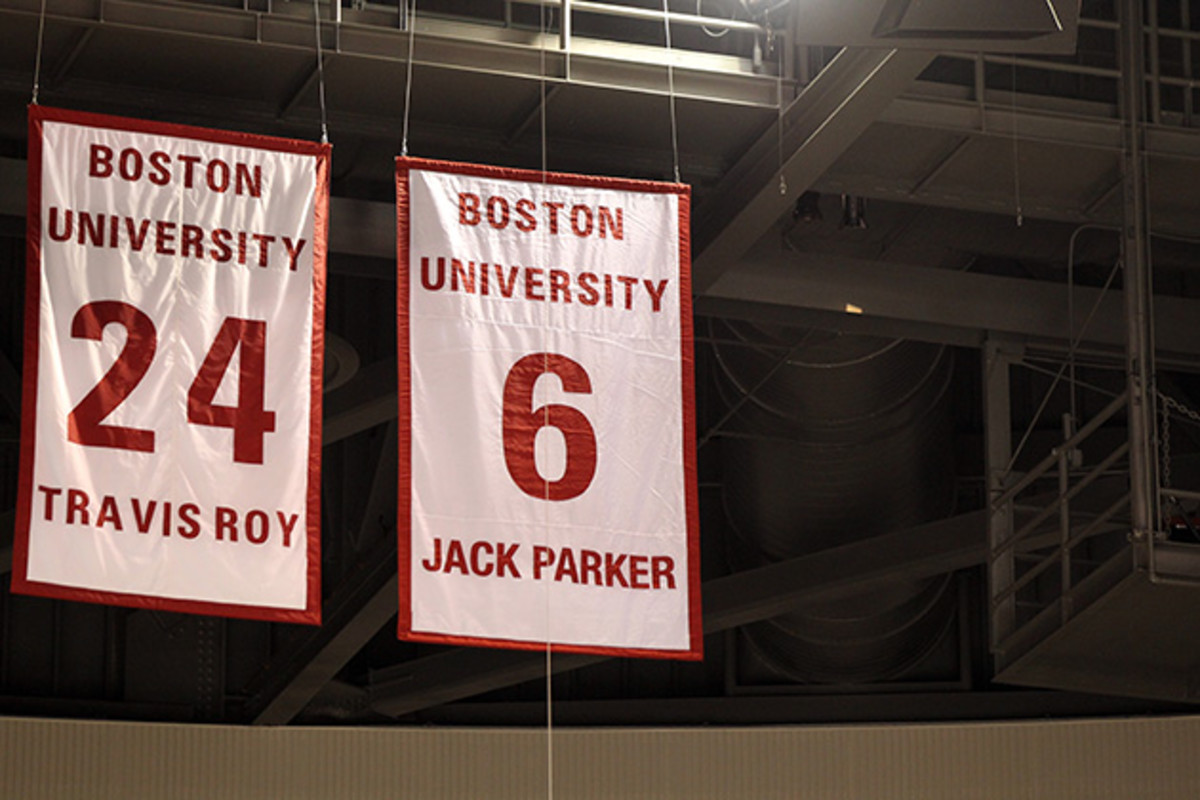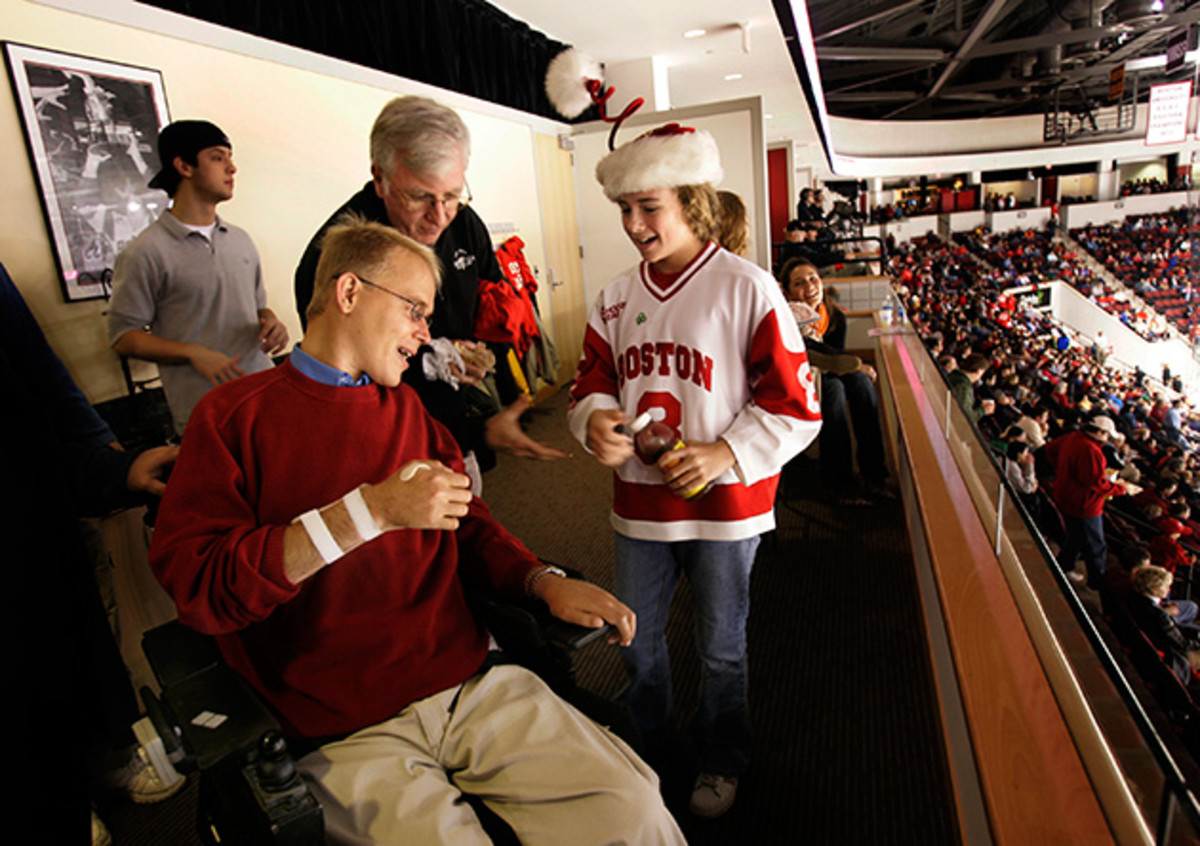Travis Roy's story inspires innovation in spinal research over 20 years later

Editor's note: Travis Roy died on Oct. 29, 2020, from complications of being a quadriplegic for 25 years, a Roy family spokesman said.
For fans of college hockey, Travis Roy’s stark, enduring reality is difficult to square with the image of a promising, handsome Boston University freshman winger. Roy has now spent half his life in a wheelchair. Twenty years.
On Oct. 20, 1995, at BU’s Walter Brown Arena, a 20-year-old Roy went barreling into a corner, chasing North Dakota’s Mitch Vig. Roy missed his check, crashed into the boards, and crumpled to the ice.
Roy’s fourth and fifth vertebrae fractured, paralyzing him. It was a swift and dramatic fall for a young man who had immersed himself in hockey.
SI VAULT: TRAVIS ROY'S ELEVEN SECONDS
“I could go on forever about how saturated I was in everything about the game,” says Roy, who spoke to Edge recently from his home in Boston. “Every scent that I had, as a child. The taste of the sweat around your mouth. I was just so in tune with all of that. There’s nothing better than going to a rink, getting a stick, touching it, flexing it.”
The son of a rink manager, Roy saw his childhood dreams realized when he donned the scarlet and white of the BU Terriers, alongside the likes of future Hobey Baker winner Chris Drury.
The Comeback: Patience, hard work returned Kevin Love to top NBA form
“I was very excited about the next six, seven, eight years, to see where my hockey career was going to take me,” Roy says. “You have to have a desire to compete, at whatever it is you choose, whether you want to be a doctor, a musician, a mechanic. But hopefully, at some point in the journey, you find something that you’re passionate about. And then you ask those questions: What’s my potential. How far can I take it? How good can I be? Hockey was that thing for me.”
Then, 11 seconds after Roy hopped over the boards for his first shift, those dreams shattered like so many shards of ice. Even now, two decades later, Roy isn’t sure how he’ll react each time he watches the video of the accident during his speaking engagements.
“Obviously, it’s a very powerful moment,” he says. “It’s a video of a life altered drastically. It’s also hard because there were so many questions. I didn’t know what life was going to be like. All I knew was that everything I had known had ended at that moment.
“So, 20 years later, it’s more of a story. And the story isn’t nearly as tragic or as sad. It’s about getting my life back.”
Roy’s subsequent struggles and successes are well documented, beginning with his autobiography, Eleven Seconds, written with Sports Illustrated’s E.M. Swift. Through months, and then years, of rehabilitation, Roy endured all five stages of grief—denial, anger, bargaining, depression, and acceptance. In a very real sense, part of Roy died that night.
“I think about hockey daily, and throughout the day,” Roy says. “It never left me. Hockey was my first love.”
While hockey may have defined Roy, he refused to allow its loss to deter him. He has continued to move forward, despite being wracked early on by doubts, despite being wheelchair bound, and despite requiring around-the-clock care.

“I didn’t know the burden I would be on my parents and my family, or what options there would be,” he says. “I didn't understand the whole home-care business.”
Roy’s financial and medical needs have been met by an NCAA catastrophic injury policy. But the mental resolve has come from within. Roy said he draws his strength from his parents, Brenda and Lee, and from his Maine upbringing.
“It goes back to my Dad’s comment, when he first walked out on the ice [in the moments after the injury],” says Roy. “‘Come on, Trav, get up. You’re not hurt.’ That was my Dad. Shake it off. And up until that moment, he was always right.
“That's how I live. That's how I was brought up. I come from Maine. There’s some unique values that Maine inspires. Hard work and community. There’s a bond that’s created there, dealing with long winters, chopping wood, shoveling and plowing. There are responsibilities that you don’t always find elsewhere. It’s tough to get up in the morning when it’s zero out. You have to be tough.”
Get Healthy in 2016: How meditation, sleep and more can calm your mind
Roy’s accident tested his toughness, his mettle. But he didn’t have to go it alone. In addition to his family, the hockey community was there for Roy. Jack Parker, the legendary BU bench boss, has often said that the worst thing to happen to him as a coach was Roy’s accident, but that the best thing was the response from the BU hockey family. Roy agrees.
“If you’re going to break your neck,” he says, “you want to do it as a hockey player, because the hockey community is just incredible.”
Two years after his accident, Roy, with a boost from Boston financial circles, launched the non-profit Travis Roy Foundation, which aims to increase awareness and funding for spinal chord injuries, and provide assistance for those with injuries similar to Roy’s. In the past 18 years, the foundation has raised and distributed more than $5 million for adaptive medical equipment and research.
“I want to keep [spinal chord injuries] relevant,” Roy said. “I’m trying to keep it out there. I want people to know I'm doing O.K. I want to convey that there are people in similar circumstances who aren’t doing O.K.”
This past October, to mark the 20th anniversary of Roy’s accident, the Boston business community (which counts many former collegiate hockey players among its numbers) and all four major Boston sports teams raised another $1 million for the foundation. Furthermore, Roy’s alma mater received another $2½ million anonymously to fund a rehabilitation science professorship and an office at BU for his foundation.

“I wouldn’t say we’re having a huge impact, by any means, but we’re at a level where we’re funding some of the top researchers in the country, helping move their labs along,” says Roy. “And that makes me feels good.
“The second piece is adaptive-equipment grants. We’ve provided for over a thousand individual grants. Sometimes I think that’s not a very big number, when I think of the big picture. But all you have to do is watch one family that got one elevator lift so that their son, daughter, father, can integrate with the family on all levels. Or that one voice-activated computer that allows somebody to go back to school, or access the Internet. It changes lives, it improves lives. It removes burdens for the family, for their loved ones.”
Furthermore, Roy said he believes the science of treating spinal chord injuries is on the cusp of dramatic advancements.
“For the first 15 years, 18 years, hope was pretty intangible,” Roy says. “It was a feeling, it was an emotion, and I couldn’t have lived without it. But, for me, the last few years, when I look at the future, hope is becoming very tangible.
The left-handed logic of New York Giants wideout Odell Beckham Jr.
do this.’”
That assertion warms Parker’s heart. The coach with more hockey victories at a single institution (897) has stood beside Roy for the past two decades. He twice turned down offers from the NHL, including a chance to coach the Boston Bruins, because of his concerns for Roy.
Parker recalls a night 15 years ago, shortly after Roy re-enrolled at BU, when the two had dinner together. On the way home—Parker has a Boston apartment close to Roy's condominium—Roy was visibly troubled.
“So I asked him what was going on,” says Parker. “And he said, ‘I know I’m never going to have any passion in my life like I did for hockey. I want to be a good son, and graduate from college. And who knows what I’ll do for a living. But I know nothing will ever touch me like hockey did.’ He was so upset about it. I said, ‘Travis, you don’t know.’ And he said, ‘Oh yeah, I know it.’
“So I told him, ‘There’s an old saying, that God doesn’t shut one door without opening up another. He said, ‘I don't believe that’ And I said, ‘You don’t have to believe it. Believe that I believe it.’”
Fast forward to the spring of 2015, when Parker got a call from an old coaching colleague, Donald (Toot) Cahoon, who also played at BU. Cahoon had a friend whose grandson was in Europe when he dove into a lake, breaking his neck. The young man had just returned home to the Boston, and Cahoon hoped that Parker could reach out to Roy to see if the foundation could help. But when Parker called Roy, his former player was one step ahead of him.
The SI Extra Newsletter Get the best of Sports Illustrated delivered right to your inbox
Subscribe
“Travis says, ‘I already saw him,’” says Parker. “I said ‘How did you know about it?’ And he says, ‘I know about everything.’”
What Parker discovered was that Boston’s Spaulding Rehabilitation Hospital apprises Roy of any new patients that his foundation might be able to assist.
“I could hear it in his voice, how excited he was to tell me about what he was doing,” says Parker. “I could also hear how proud he was to be helping these people. I told him that was fabulous. And I said to myself, ‘Well, you found your passion now, Travis. And what you’re doing now has a lot more impact than a hockey player.’”
But Roy, who received his communications degree from BU in 2005, parses those words. To him, there is a clear, and sometimes harsh, distinction between passion and purpose.
“Passion is a lot of fun. Having passion is magical,” he says. “The last 18 years, slowly, I’ve developed a sense of purpose.”
That purpose, says Roy, is the ability to leverage his misfortune to benefit others.
“It has great value, but it’s not as much fun,” he says. “It’s work. It’s long hours. But it is rewarding. It is not rewarding in a way that you had a blast and can't wait to do it again, like hockey. It’s rewarding in a way where I can look back and see that I have done something with my life that absolutely has value.”
Dan Ronan, Roy’s former teammate and roommate, serves on the board of the Travis Roy Foundation. He says that Roy’s foundation is an extension of the young man who “genuinely took an interest in different people at BU.”
Adds Ronan, “Travis is very special. I’m amazed how his story has transcended time. It’s amazing that 20 years later, people still talk about him and remember him. While he had the shortest sports career of anyone in the city, he is known and loved like the giants of the Boston sports world.”
For details on the Travis Roy Foundation, visit travisroyfoundation.org.
